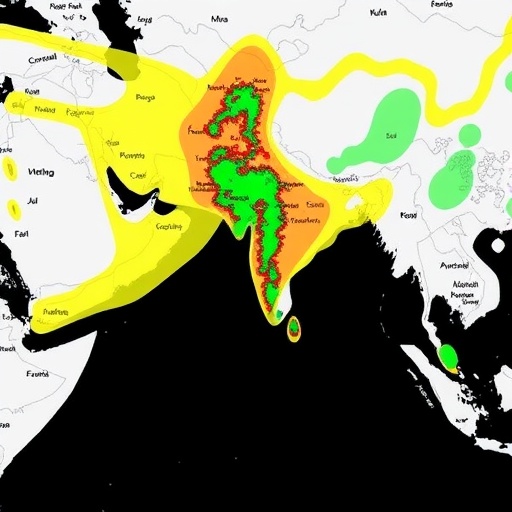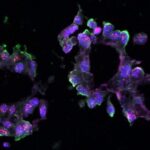
In a landmark study published in Nature Microbiology in 2025, a collaborative team of researchers has unveiled a high-resolution chromatin interaction map of the Plasmodium falciparum genome, illuminating the intricate network of regulatory pathways that orchestrate the parasite’s complex life cycle. This work elucidates how the MORC (Microrchidia) proteins, in concert with ApiAP2 transcription factors, coordinate long-range genomic interactions, effectively linking distantly located genes that share functional relationships. This newfound understanding holds profound implications for malaria biology and could chart new courses for therapeutic intervention.
Plasmodium falciparum—the deadliest species of malaria-causing parasites—has challenged researchers for decades due to its highly dynamic genome architecture and intricate gene regulation mechanisms. Unlike many model eukaryotes, P. falciparum employs a multilayered regulatory landscape to tightly control gene expression during its developmental stages within human and mosquito hosts. The revelation of how distantly positioned genes in the parasite genome physically and functionally connect provides a fresh vantage point on these regulatory networks that underpin parasite virulence, immune evasion, and transmission.
Central to this research is the generation of a comprehensive, high-resolution chromatin contact map, achieved using cutting-edge chromosome conformation capture techniques adapted specifically for P. falciparum. This approach allows precise delineation of genomic loci in spatial proximity despite being megabases apart on the linear genome. Such spatial chromatin organization is integral to orchestrating coherent transcriptional programs, enabling coordinated gene expression responses vital for the parasite’s survival in diverse environments.
.adsslot_jfFO7yoGaw{width:728px !important;height:90px !important;}
@media(max-width:1199px){ .adsslot_jfFO7yoGaw{width:468px !important;height:60px !important;}
}
@media(max-width:767px){ .adsslot_jfFO7yoGaw{width:320px !important;height:50px !important;}
}
ADVERTISEMENT
The pivotal role of MORC proteins emerged from their suspected function as architectural proteins that modulate chromatin looping and higher-order genome folding. Originally characterized in plants and mammals, MORC proteins are increasingly recognized as key players controlling chromatin state and gene silencing. This study confirms their presence and function in P. falciparum, uncovering their unique interaction with ApiAP2—an exclusive Apicomplexan family of transcription factors essential for stage-specific gene regulation.
ApiAP2 proteins, which bind specific DNA motifs, serve as the primary transcriptional regulators in P. falciparum, compensating for the parasite’s relative paucity of canonical eukaryotic transcription factors. By mapping the binding sites of these ApiAP2 factors and overlaying them with MORC occupancy and chromatin interaction data, the researchers demonstrate that these two components coalesce to form long-range chromatin loops. These loops bring distal genes together into transcriptional hubs, facilitating synchronized regulation.
Such spatially mediated gene regulation challenges past assumptions that gene expression in P. falciparum is predominantly regulated by local promoter-proximal elements alone. Instead, the study reveals a complex genome-wide wiring diagram where physically distal but functionally related genes engage in crosstalk, potentially amplifying or fine-tuning transcriptional outputs essential during the parasite’s erythrocytic cycle and transmission stages.
Remarkably, the researchers identified clusters of genes implicated in antigenic variation, metabolic adaptation, and invasion machinery co-localizing in 3D nuclear space. This finding suggests that antigen-encoding var, rifin, and stevor gene families, previously noted for mutually exclusive expression patterns, might be regulated not only by epigenetic marks but also through long-range chromatin interactions orchestrated by the MORC/ApiAP2 axis.
Further biochemical and genetic perturbation experiments underpin the causal role of MORC proteins in shaping these chromatin contacts. Knockdown of MORC genes leads to dismantling of specific loops, derepression of normally silent loci, and dysregulation of crucial stage-specific genes. These phenotypic consequences underscore MORC’s potential as a master regulator, modulating genome architecture and transcriptional fidelity critical for parasite development and pathogenicity.
The integration of Hi-C contact matrices with chromatin immunoprecipitation sequencing (ChIP-seq) for ApiAP2 and MORC binding allowed the construction of a detailed interactome map. This map provides an unprecedented spatial blueprint of the P. falciparum genome during the blood stage infection, highlighting key regulatory nodes, hubs of transcriptional activity, and potential epigenetic switch points that could serve as promising drug targets.
Beyond expanding our fundamental understanding of parasite biology, these insights into MORC/ApiAP2-mediated chromatin looping open avenues for targeted malaria interventions. Small molecule inhibitors designed to disrupt these architectural protein functions could collapse critical transcriptional circuits, impairing parasite development or transmission competence without affecting human host cells. Given the vital and specific role of ApiAP2 and MORC within the parasite nucleus, these factors represent enticing candidates for next-generation antimalarial therapies.
Moreover, the study’s methodological advances in adapting chromatin conformation capture techniques to a notoriously AT-rich and challenging genome set a benchmark for future investigations into other apicomplexan pathogens. Understanding chromatin architecture’s role in pathogenesis extends well beyond P. falciparum, potentially informing strategies against Toxoplasma, Babesia, and related parasites.
In the broader context of epigenetics, this research exemplifies how 3D genome organization interweaves with transcription factor networks to enforce stage-specific gene expression in a unicellular eukaryote with substantial public health relevance. Such multilayered regulation exemplifies evolutionary innovation in gene control, demonstrating that even relatively streamlined genomes possess sophisticated mechanisms to orchestrate complex biological processes.
The implications stretch to vaccine development as well. By pinpointing genomic regions involved in coordinated regulation of virulence factors, this map could guide antigen selection, improving immunogen design to target functionally interlinked pathogenic determinants. Fine-tuning immune responses against these hubs may enhance vaccine efficacy and durability.
Intriguingly, the spatial genome dynamics revealed may also help explain how P. falciparum balances the demands of rapid replication and immune evasion. The ability to toggle gene clusters en masse through chromatin reorganization rather than sole reliance on point mutations or local promoter regulation adds a new layer of adaptability to its arsenal.
While this study focuses on blood-stage parasites, ongoing work aims to map chromatin architecture across other life cycle stages, including mosquito vector stages and liver schizogony. Such temporal and spatial maps will progressively reveal how chromatin remodeling interfaces with environmental cues and developmental signals, presenting a comprehensive picture of malaria parasite regulation.
In conclusion, Singh, Serizay, Couble, and colleagues have provided the malaria research community with an invaluable resource and conceptual framework for understanding the spatial genome logic of P. falciparum. By decoding the rules governing long-range chromatin interactions mediated by MORC and ApiAP2, they have opened the door to novel molecular targets and innovative strategies to combat one of humanity’s oldest scourges.
Subject of Research: The spatial genome organization and regulatory mechanisms of the Plasmodium falciparum genome, focusing on MORC and ApiAP2-mediated chromatin interactions linking distant, functionally related genes.
Article Title: High-resolution map of the Plasmodium falciparum genome reveals MORC/ApiAP2-mediated links between distant, functionally related genes.
Article References:
Singh, P., Serizay, J., Couble, J. et al. High-resolution map of the Plasmodium falciparum genome reveals MORC/ApiAP2-mediated links between distant, functionally related genes. Nat Microbiol (2025). https://doi.org/10.1038/s41564-025-02038-z
Image Credits: AI Generated
Tags: ApiAP2 transcription factors rolechromatin interaction in Plasmodium falciparumchromosome conformation capture techniques in genomicsevolutionary biology of malariagene regulation in malaria parasitesgenomic interactions in parasiteshigh-resolution Plasmodium mapimmune evasion mechanisms of Plasmodiummalaria biology research advancementsMORC gene function in malariaPlasmodium falciparum genome architecturetherapeutic targets for malaria



